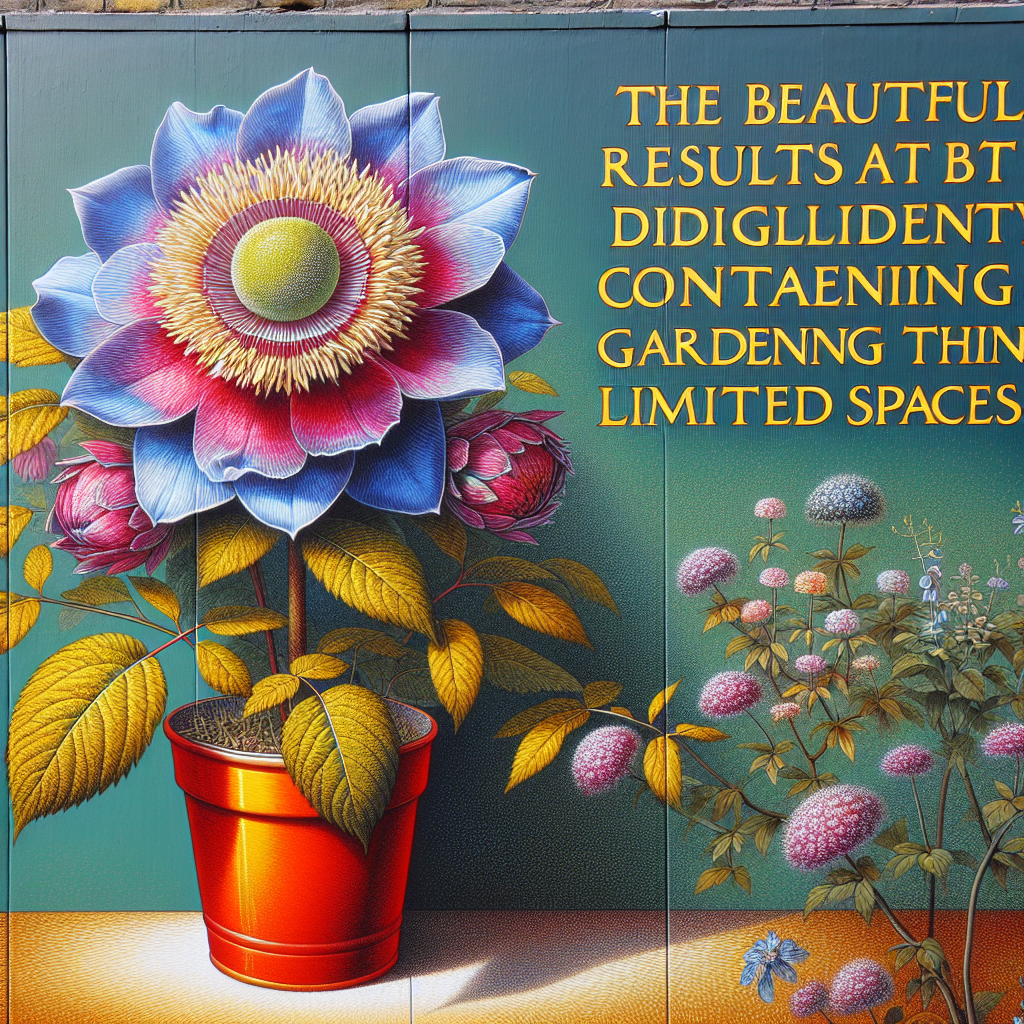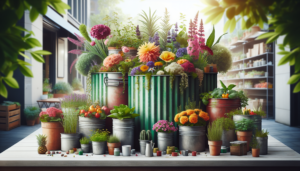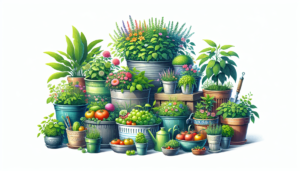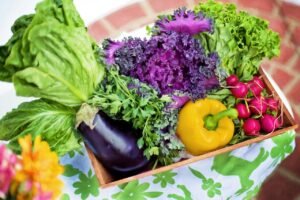
Are you interested in gardening but don’t have a large backyard? Fear not, because this article will show you how to grow a thriving container garden right here in Northern Virginia! From colorful flowers to fresh herbs and vegetables, container gardening is a fantastic way to exercise your green thumb and beautify any limited space that you have available. Whether you have a balcony, a small patio, or even just a windowsill, we’ll provide you with all the tips and tricks you need to successfully cultivate a lush and thriving garden in containers. Get ready to bring the joy of gardening to your doorstep!
Choosing the Right Containers
Size and Depth
When choosing containers for your garden in Northern Virginia, it’s important to consider the size and depth of the pots. Larger containers generally provide more room for root development and retain moisture better than smaller ones. However, make sure the container is not so big that it becomes difficult to move or accommodate in your garden space.
Material
The material of the containers can greatly impact the plants’ growth and the overall aesthetics of your garden. Opt for containers made of durable materials such as plastic, fiberglass, or ceramic. These materials are lightweight, weather-resistant, and suitable for the diverse climate of Northern Virginia.
Drainage
Proper drainage is essential for the health of your container plants. Ensure that your chosen containers have drainage holes at the bottom to allow excess water to escape. If your pot doesn’t have drainage holes, consider creating them using a drill or by adding a layer of gravel at the bottom to prevent water from pooling around the roots.
Selecting the Right Plants
Consider Your Space
Before selecting plants for your container garden, assess the available space in your garden. Determine whether you have ample sunlight, shade, or a mix of both. Take into consideration the size of the containers and the potential growth of the plants to ensure they will fit well in your garden space.
Sunlight Needs
Different plants have varying sunlight requirements. Some thrive in full sun, while others prefer partial or full shade. Consider the amount and intensity of sunlight your garden receives throughout the day and choose plants accordingly. For a successful container garden in Northern Virginia, choose plants that are well-suited to the region’s climate and sun exposure.
Temperature and Climate
Northern Virginia experiences both hot summers and cold winters. When selecting plants for your container garden, make sure they can withstand the temperature extremes of the region. Choose plants that are suitable for the USDA hardiness zone of your specific area in Northern Virginia to ensure their survival and growth.
Preparing the Containers
Cleaning
Before planting, it’s important to clean your containers to remove any dirt, dust, or residue from previous plantings. Use a mixture of water and mild soap to gently clean the containers. Rinse thoroughly and allow them to dry completely to prevent the spread of diseases or pests.
Adding Drainage Holes
If your containers don’t have drainage holes, it’s crucial to add them to ensure proper drainage. Use a drill to create several small holes at the bottom of the containers, ensuring that they are evenly spaced. These holes will allow excess water to escape and prevent waterlogged soil that could lead to root rot.
Choosing the Right Soil
Selecting the right soil is vital for the success of your container garden. Use a high-quality potting mix specifically formulated for container gardening. Avoid using garden soil, as it tends to be too heavy and may not provide adequate drainage. Look for potting mixes that are lightweight, well-draining, and rich in organic matter to provide the optimal growing medium for your plants.
Planting Techniques
Plant Selection
When planting in containers, consider the growth habits of the plants and how they will interact with each other. Choose plants that have similar care requirements, such as water and sunlight needs, to ensure they thrive together in the confined space of a container. Better yet, select plants that complement each other visually, whether through contrasting colors, textures, or heights.
Spacing
Proper spacing is crucial in a container garden to allow each plant enough room to grow and access essential resources. Refer to the care guidelines of each plant to determine the recommended spacing. As a general rule, smaller plants should be spaced closer together, while larger plants need more room to spread their roots and foliage.
Watering
Container plants typically require more frequent watering than those in the ground, as they can dry out more quickly. Check the moisture level of the soil regularly by inserting your finger about an inch deep. If it feels dry, it’s time to water. Be sure to water thoroughly, until excess water drains out of the bottom of the container. Avoid overwatering, as it can lead to root rot and other plant health issues.
Caring for Your Container Garden
Watering
Consistent and proper watering is essential to keep your container garden healthy and thriving. During hot summer months, you may need to water daily, while cooler periods may require less frequent watering. Adjust your watering schedule according to the specific needs of your plants and the environmental conditions of Northern Virginia.
Fertilizing
Container plants often require regular fertilization to replenish nutrients that may have been washed away by frequent watering. Use a balanced, slow-release fertilizer specifically formulated for container plants. Follow the instructions on the fertilizer packaging for the appropriate application rates and timing.
Pruning and Trimming
Regular pruning and trimming help promote healthy growth and maintain the shape and size of your container plants. Remove any dead or diseased foliage and trim back overgrown branches to encourage new growth. Prune plants after the flowering season or as needed to prevent them from becoming leggy or overcrowded.
Dealing with Pests and Diseases
Identifying Common Pests
Common pests that may affect container plants in Northern Virginia include aphids, whiteflies, spider mites, and caterpillars. Pay attention to any signs of damage or infestation, such as curled leaves, chewed foliage, or sticky residue on leaves. Identify the specific pest causing the issue to determine the appropriate treatment method.
Prevention Methods
Preventing pest infestations is key in maintaining a healthy container garden. Regularly inspect your plants for early signs of pests and take immediate action. Avoid overcrowding plants, as it can create a favorable environment for pests. Keep your containers and surrounding areas clean and free of debris, which can harbor pests. Additionally, practice good hygiene by washing your hands and tools before handling different plants to prevent the spread of diseases.
Natural Remedies
Incorporating natural remedies can help control pests and diseases in your container garden. Use organic insecticidal soaps or neem oil to combat common pests. Introduce beneficial insects, such as ladybugs or lacewings, that feed on harmful pests. Natural remedies not only keep your garden free from chemical pesticides but also promote a healthy ecosystem.
Harvesting and Enjoying Your Yield
Knowing When to Harvest
Knowing the right time to harvest your crops is essential to ensure optimal flavor and nutritional value. Refer to specific plant guidelines for the best time to harvest different vegetables or fruits. Harvesting too early or too late can result in a subpar taste or texture.
Harvesting Techniques
Each crop has its own unique harvesting technique. Some crops, like tomatoes or peppers, can be gently twisted or cut from the plant when ripe. Others, like leafy greens, can be harvested by plucking outer leaves. Use appropriate tools, such as shears or pruners, to avoid damaging plants or spreading diseases.
Enjoying Your Homegrown Produce
After all the hard work and care put into your container garden, it’s time to enjoy the fruits of your labor. Incorporate your homegrown produce into delicious meals, salads, or even freshly squeezed juices. Share the bounty with friends and family, or consider preserving surplus harvest by freezing, canning, or drying for future use.
Extending the Growing Season
Using Row Covers
Row covers can help protect your plants from frost and extend the growing season. Covering your containers with row covers during colder months can create a mini-greenhouse effect and shield your plants from the harsh elements. Make sure to remove the covers during the day to allow air circulation and prevent overheating.
Providing Extra Protection
In colder climates like Northern Virginia, additional protection may be necessary to safeguard your container garden during freezing temperatures. Move containers closer to the house or place them in a sheltered corner to benefit from the radiant heat. Use insulating materials like straw or bubble wrap to wrap containers and protect the roots from cold exposure.
Choosing Cool-Season Crops
To maximize the growing season, consider planting cool-season crops in your container garden. Vegetables like lettuce, kale, spinach, and radishes thrive in cooler temperatures and can be grown early in the spring or late in the fall. These cool-season crops can tolerate light frosts and will provide you with an extended harvest period.
Overcoming Challenges in Northern Virginia
Drought Tolerance
Northern Virginia experiences periods of drought, which can be challenging for container gardens. Select drought-tolerant plants such as succulents, lavender, or rosemary. These plants have adapted to arid conditions and require less water, making them suitable for container gardening in areas with limited rainfall.
Cold Tolerance
The cold winters of Northern Virginia can pose challenges to container plants. Choose plants that are cold-tolerant and can withstand freezing temperatures. Consider using insulating materials like burlap or frost blankets to protect your plants during severe cold snaps.
Pest and Disease Pressure
Northern Virginia is home to a variety of pests and diseases that can impact container plants. Stay vigilant and regularly inspect your plants for any signs of damage or infestation. Practice good sanitation by removing any dead or diseased plant material promptly. Consider companion planting techniques to deter pests naturally and attract beneficial insects that help control harmful pests.
Connecting with the Gardening Community
Joining Local Garden Clubs
Joining local garden clubs can provide an opportunity to connect with fellow gardening enthusiasts in Northern Virginia. These clubs often organize workshops, plant exchanges, and garden tours, allowing you to learn from experienced gardeners and share your experiences.
Attending Workshops and Seminars
Attending workshops and seminars is a great way to enhance your gardening knowledge and skills. Look for gardening-related events in your area, such as plant care workshops, container gardening seminars, or landscaping classes. Participating in these educational opportunities will expand your gardening repertoire and provide valuable insights.
Participating in Garden Share Programs
Consider participating in garden share programs, where gardeners in your community can exchange plant cuttings, seeds, or surplus harvest. These programs foster a sense of community and provide an avenue to meet other like-minded individuals who share your passion for gardening. Additionally, garden share programs contribute to resource conservation and sustainability by promoting the reuse and sharing of plants and produce.







